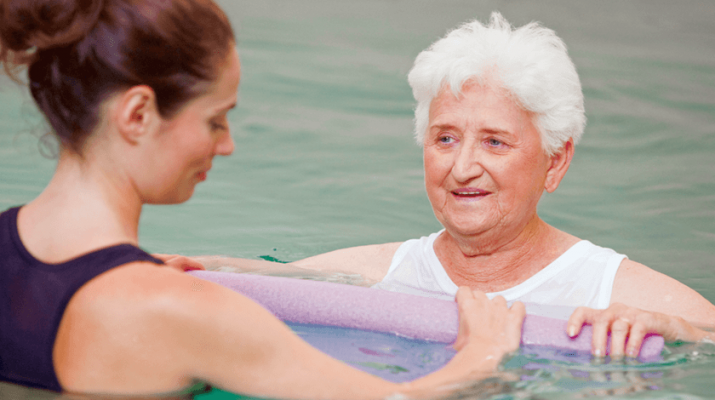Feeling great through aquatic therapy
By Barbara Pierce
“I always feel so great when I get out of the water!” said 68-year-old Elaine Wozniak of Port Charlotte, Fla. about her aquatic therapy.
Wozniak suffers from arthritis; on land, she walks slowly and painfully. “In the water, I can do anything,” she said.
“Our aquatic therapy uses water for therapy instead of land,” explained Dr. Shawna Marmet, outpatient clinical supervisor at Sitrin Health Care Center, New Hartford.
For patients of all ages, there are few therapeutic modalities more soothing than water.
Not only will aquatic therapy make you feel great, it’s the best way to exercise as it brings a large variety of benefits.
Water is a wonderful place to exercise for many reasons. Even just standing in the water, the pressure provides much benefit. The buoyancy of the water supports your body weight, which makes it easier on your joints. This provides a great advantage if you’ve got arthritis or are overweight.
The joints can more easily be moved in the water, and there is no resulting joint pain.
The buoyancy of the water helps with ease of movement and lessens pain, Marmet explained. Aquatic therapy offers many advantages and benefits to people with a variety of illness and conditions, or who are recovering from all phases of injury or surgery. The water temperature is set at 92 degrees, an ideal temperature for therapy in the water.
People who are treated in the pool have a wide range of conditions, everything from back or joint pain, post-surgical therapy following hip or knee replacement, fibromyalgia, arthritis, rheumatologic, neurological, to chronic pain.
The therapeutic properties of water, combined with the skill and specialized training of aquatic therapists, help improve mobility and function for patients. You do not have to be a swimmer to participate in or benefit from water therapy.
Sitrin is the only provider of pool therapy in the area. Like all of its therapy, pool therapy is one-on-one and sessions last 30 minutes. People generally come two or three times a week.
Many people come for pool therapy, and are enthusiastic about its benefits. They often come back for sessions time and time again, because of the multiple benefits they receive.
“Pool therapy definitely helps reduce pain,” added Scott Miller, a physical therapist at Sitrin. “I hear this every day. People come in, sore and in pain. They get in the water, and they come out happy.”
The benefits happen quickly, as attested to by a woman in her 60s.
“She rolled into the pool area in her wheelchair,” Marmet said. “We used the chair lift to get her in and out of the pool for her therapy. After just three weeks of pool therapy, she was able to climb in and out of the pool without assistance and was able to walk in the pool.”
Fluid transition
The density of the water leads to increased resistance, which means you get quicker results exercising in the water than you do exercising on land.
“The biggest misconception about pool therapy is that people think they’re here to swim; they think they’re going to swim laps,” said Miller. “No, there is no swimming involved. We exercise.”
“The type of activities we do in the water depends on the diagnosis; each session is tailored for that individual person. He or she might walk in the water, do bicycling, or upper body movements. When you first come in, we do an evaluation to determine what will be most helpful for you,” Miller added.
“I see a lot of people who come in for back pain,” he noted. “The buoyancy of the water makes it easy for them to move. The water is warm; not as hot as a Jacuzzi, but perfect for exercising.”
To learn more about Sitrin’s aquatic therapy or other therapies, call 315-737-2246 or visit http://www.sitrin.com/medical-rehabilitation/outpatient/aquatic-therapy.

